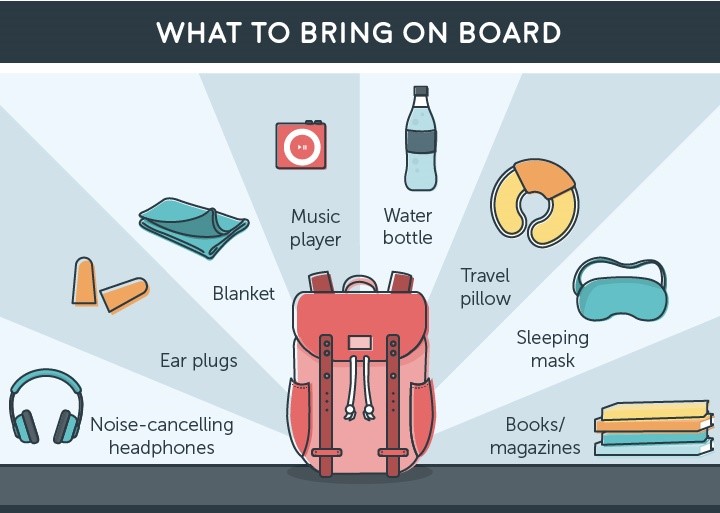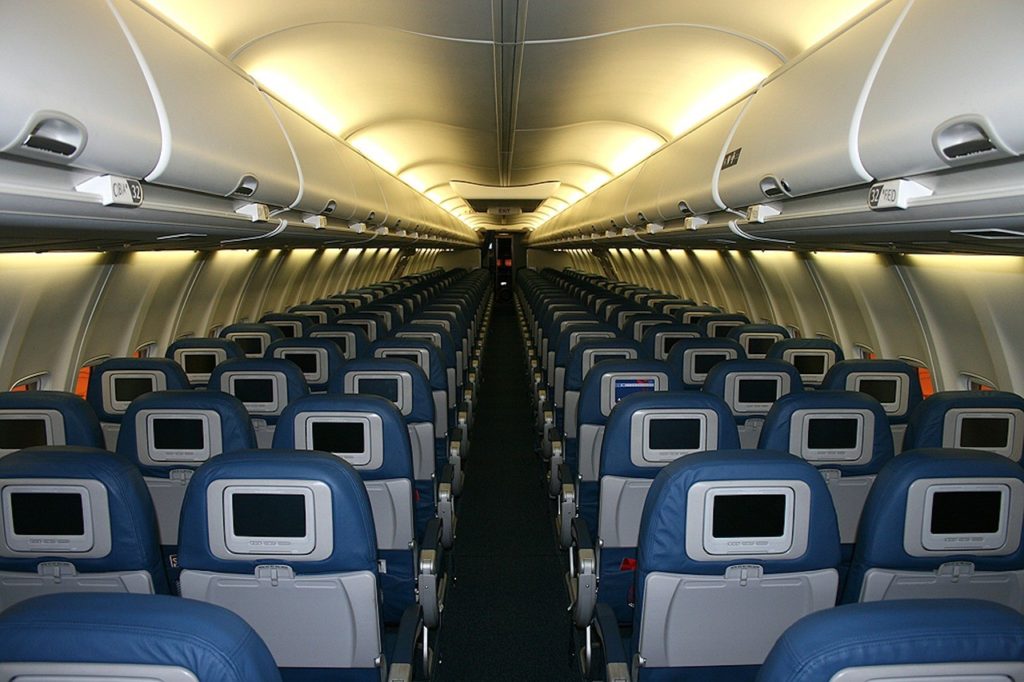After dozens of long-haul flights, I’ve come to realize that the difference between a good trip and a bad one is the amount of sleep I get.
It’s no surprise, really: doctors keep saying we need more sleep.
But with the noise of the aircraft and so many people on board, knowing how to sleep on a plane has become an invaluable skill for travelers.
During a long flight, it’s only natural to want to pass the time by falling asleep. Even pilots do it! Once you get through airport security, your next step is to plan for a comfy flight.
These 10 easy tips will help you get some rest next time you hop on a plane.
1. Buckle your Seatbelt over the Blanket
What could be worse than being in the middle of your dream, (almost) comfortable in your seat, only to be wakened up by the flight attendant who needs to check if you have buckled your seatbelt?
Nothing!
To avoid this, make sure to wrap yourself in your blanket, and only then, buckle your seatbelt.
This way, even if you fall asleep, flight attendants will still see that you do have your seatbelt on and let you sleep in peace.

Source: Johnny Jet
2. Find a Good Position
If you’re flying in Business Class, this shouldn’t be too hard.
Now, if you’re in the Economy, it might get tricky. The objective is to find a position that will be as flat as possible and put little pressure on your back.
So start by putting your seat as far back as possible. Don’t worry about bothering the passenger behind you, everyone will do it when you fly by night. It is the most natural position for sleeping.
3. Pack the Right Gear
When you’re in your bed, at home, I’m guessing that you sleep at least with a blanket to keep you warm, right? Well, do the same on the plane! Keeping your body at a nice, rather warm temperature will send you on your way to Sleepytown. There is simple gear that you can pack in your luggage that will make your travel easier.
I also recommend that you use a U-shaped pillow – but not as they are meant to be used. Instead of putting it at the back of your neck, put it in the front, so your chin can rest on it. It will prevent your head from bobbing up and down and waking you up. I use an inflatable pillow, to adjust it exactly the way I want and save space in my carry-on.
To avoid being awakened by the lights of the plane, bring a mask along with you to cover your eyes. A scarf can also do the trick.
But the main enemy that you will face when trying to fall asleep on a plane is noise. From passengers too, but mainly from the aircraft itself. You can fight back by bringing a set of earplugs – but your best chance of winning is to use noise-canceling headphones. It’s worth the investment I think – I use mine all along my trip, not only during the flight.
Plus, with your headphones on, your neighbors are less likely to engage in the conversation at a time when all you want is to sleep.

Source: Business Travel Life
4. Wear Comfortable Clothes
Start by removing your shoes. Sleeping in your bed with your shoes wouldn’t cross your mind, right? Just wearing your socks will make you instantly more at ease.
Some frequent fliers go as far as changing into their pajamas once they have boarded the plane. If that would make you feel uncomfortable, just opt for large pants.
To avoid deep vein thrombosis (DVT), doctors recommend using compression stockings. The idea is that you don’t prevent the blood from flowing in your legs.
Forget about looking good: to get some Z’s on a plane, comfy is the new black!
Related posts:
- Flying With a Baby: What You Need to Know for a Hassle-Free Trip
- 10 Tips to Make Sure You Have a Pleasant Journey
- 8 Travel Mistakes You Need to Avoid
- Top Reasons Why Flying Sucks
5. Avoid Screens before Sleeping
The light from your laptop and smartphones won’t help you sleep. You may think it will because you feel like your eyes are getting tired, but all it actually does is keep your brain awake and damage your eyes.
So stay away from all screens before going to sleep. If you really must, then download f.lux: it removes some of the blue light produced by your screen and helps you sleep better.
But your best option remains a good old book or a Kindle!
As a last resort, pop a pill to help you fall asleep. But ask your doctor about it before your flight, and take it at the appropriate time if you don’t want to feel completely groggy when the plane lands.
There are also people arguing that sleeping on a plane while at a high altitude could damage your hearing. That’s just a word of warning, I don’t think it should stop you from sleeping during your next flight!
6. Book a Non-Stop Flight (or the most Direct Route)
Unfortunately for your wallet, direct and non-stop flights are usually not the cheapest ones. But they do have the advantage of getting you straight to your destination, without you having to get off the plane and back on another one.
The more time you have on one plane, the easier it is to get some quality, restorative sleep.
Imagine starting to fall into the arms of Morpheus for a couple of hours only and having to catch a connection? While I’m a big fan of napping, nothing beats a long night’s sleep without interruption to recover.
7. Fly Red-Eye
Red-eye flights are amazing. Seriously. Especially long-haul ones.
They are cheaper – which should compensate for the fact that direct flights are usually more expensive. And they allow you to save on accommodation costs because you can sleep on the plane!
The best part?
By flying red-eye, you are less likely to disrupt your usual sleeping pattern. This is not to be neglected: we are used to sleeping for 6+ hours straight in 24h.
Forcing yourself to sleep during the day might cause irregular sleep-wake syndrome. This happens when you sleep only 1 to 4 hours at a time, several times during the day. While you may still fill your sleeping hours quota during the day, you will probably experience drowsiness and maybe even insomnia.

Source: The Coffee Shop Trader
8. Choose your Seat Carefully
The main decision you have to make when booking your flight is whether to buy a First Class ticket or fly in Economy. If you’re not on a budget or have been saving miles, consider splurging on a more comfortable option.
First Class seats have the advantage of offering a lying position, making sleeping much easier. Plus, they are way more comfortable.
But even if you opt for an Economy seat, sleeping on the plane remains possible. Just know that not all seats are equal. That’s why you should check in online as soon as possible and choose your seat.
Choose a window seat: your neighbors won’t bother you when they need to go to the toilets and you will be able to lean against the window for some support.
Avoid the seats close to the toilets: they are noisier because of the passenger traffic and sometimes smelly.
Pick a seat toward the front of the engine, close to the wings. It’s also a good option if you’re scared of flying, as this part of the plane is less noisy and more stable.
Another thing to consider is the legroom. Economy seats usually have little of it, except for seats at the front – but these are often located close to the toilets. The alternative is to choose a seat in an exit row (the ones used to exit the plane in case of emergency), provided that there aren’t toilets nearby.

9. Anticipate Jet Lag
Try to adapt your sleeping pattern to your destination. Without changing it completely, transition smoothly by going to bed earlier or later (depending on whether you’re flying west or east).
Change the time on your watch and phone right at the beginning of the flight. This way, you set your mind to the time at your destination and can plan your sleep accordingly.
10. Mind what you Eat and Drink
Sorry to break it to you, but for a good night’s sleep, forget about the booze. Yes, it will make you sleepy, but you’ll only get a couple of hours of non-restorative sleep. Drink a lot of water before getting on the plane to avoid being dehydrated.
Once on the plane, if you must drink something, go for something non-alcoholic and without caffeine. Try herbal tea instead!
Regarding the food: eat something light that you won’t have trouble digesting. And please, avoid the food from the airport!
This article was originally posted on ClaimCompass.eu
Author Bio:

Thomas Busson
Thomas is the SEO and Content Strategist at ClaimCompass. Frequent traveler, he loves sharing tips and news about the industry in a simple way.

